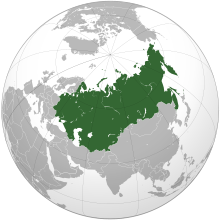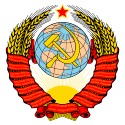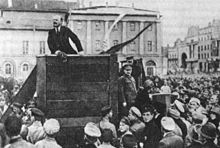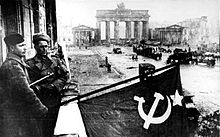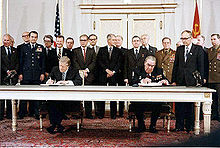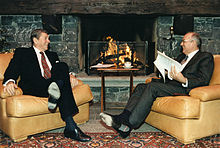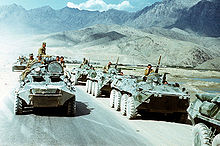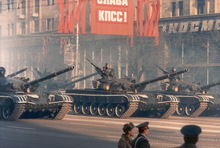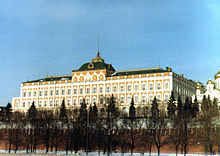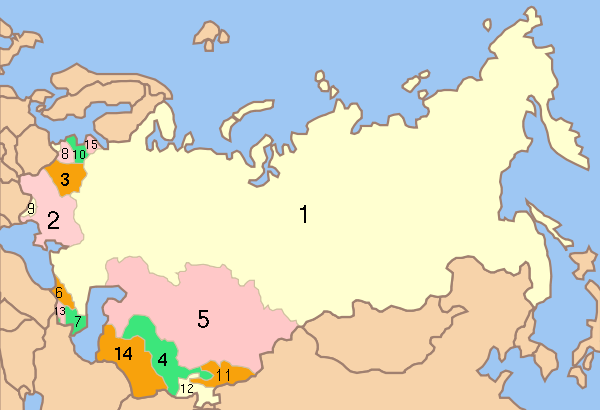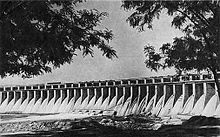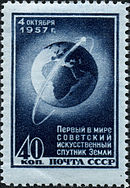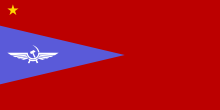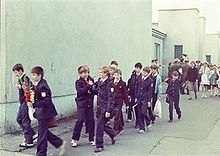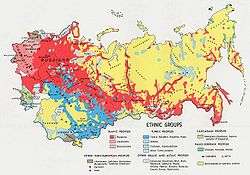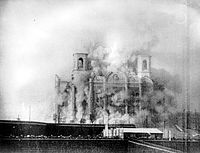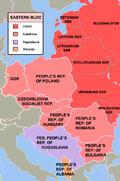- Soviet Union
-
"USSR" and "CCCP" redirect here. For other uses, see USSR (disambiguation) and CCCP (disambiguation)."Soviet" redirects here. For the term itself, see Soviet (council). For other uses, see Soviet (disambiguation).
Union of Soviet Socialist Republics
Other names
Союз Советских Социалистических Республик
Soyuz Sovetskikh Sotsialisticheskikh Respublik← 
←
←
←
1922–1991 ↓ 

Flag State Emblem Motto
Пролетарии всех стран, соединяйтесь!
(Translit.: Proletarii vsekh stran, soyedinyaytes'!)
English: Workers of the world, unite!Anthem
The Internationale (1922–1944)
National Anthem of the Soviet Union (1944-1991)The Soviet Union after World War II Capital Moscow Language(s) Russian, many others Government Single-party socialist state Leader - 1922–1924 (first) Vladimir Lenin - 1985–1991 (last) Mikhail Gorbachev Legislature Congress of Soviets and Central Executive Committee (1922-1937) Supreme Soviet (1937-1989; 1991)
Congress of People's Deputies and Supreme Soviet (1989-1991)History - Established 30 December 1922 - Disestablished 26 December 1991 Area - 1991 22,402,200 km2 (8,649,538 sq mi) Population - 1991 est. 293,047,571 Density 13.1 /km2 (33.9 /sq mi) Currency Soviet ruble (руб) (SUR) Internet TLD .su2 Calling code +7 Preceded by Succeeded by 
Russian SFSR 
Transcaucasian SFSR 
Ukrainian SSR 
Byelorussian SSR Russia 
Georgia 
Ukraine 
Moldova 
Belarus 
Armenia 
Azerbaijan 
Kazakhstan 
Uzbekistan 
Turkmenistan 
Kyrgyzstan 
Tajikistan 
Estonia3 
Latvia3 
Lithuania3 
1On 21 December 1991, eleven of the former socialist republics declared in Alma-Ata (with the 12th republic – Georgia – attending as an observer) that with the formation of the Commonwealth of Independent States the Union of Soviet Socialist Republics ceases to exist.
2Assigned on 19 September 1990, existing onwards.
3The governments of Estonia, Latvia, and Lithuania view themselves as continuous and unrelated to the respective Soviet republics.
Russia views the Estonian, Latvian, and Lithuanian SSRs as legal constituent republics of the USSR and predecessors of the modern Baltic states.
The Government of the United States and a number of other countries did not recognize the annexation of Estonia, Latvia, and Lithuania to the USSR as a legal inclusion.The Soviet Union (Russian: Советский Союз, tr. Sovetsky Soyuz), officially the Union of Soviet Socialist Republics (USSR or U.S.S.R.; Russian: Сою́з Сове́тских Социалисти́ческих Респу́блик, tr. Soyuz Sovetskikh Sotsialisticheskikh Respublik; IPA: [sɐˈjus sɐˈvʲetskʲɪx sətsɨəlʲɪˈstʲitɕɪskʲɪx rʲɪsˈpublʲɪk] (
 listen); abbreviated СССР, SSSR), was a constitutionally socialist state that existed in Eurasia between 1922 and 1991.
listen); abbreviated СССР, SSSR), was a constitutionally socialist state that existed in Eurasia between 1922 and 1991.The Soviet Union was a single party state ruled by the Communist Party from its foundation until 1990.[1] Even though the USSR was technically a union of 15 independent Soviet republics, its government and economy was highly centralized.
The Russian Revolution of 1917 caused the downfall of the Russian Empire. Following the Russian Revolution, there was a struggle for power between the Bolshevik party, led by Vladimir Lenin, and the anti-communist White movement. In December 1922, the Bolsheviks won the civil war, and the Soviet Union was formed with the merger of the Russian Soviet Federative Socialist Republic, the Transcaucasian Socialist Federative Soviet Republic, the Ukrainian Soviet Socialist Republic and the Byelorussian Soviet Socialist Republic.
Following the death of Vladimir Lenin in 1924, Joseph Stalin took power[2], leading the USSR through a large-scale industrialization program. Stalin established a planned economy and suppressed political opposition to him and the Communist party.[2][3]
In June 1941, Nazi Germany and its allies invaded the Soviet Union, breaking the non-aggression pact, which the latter had signed in 1939. After four years of brutal warfare, the Soviet Union emerged victorious as one of the world's two superpowers, the other being the United States.
The Soviet Union and its Eastern European satellite states engaged in the Cold War, a prolonged global ideological and political struggle against the United States and its Western Bloc allies, which it ultimately lost in the face of economic troubles and both domestic and foreign political unrest.[4][5] In the late 1980s, the last Soviet leader Mikhail Gorbachev tried to reform the state with his policies of perestroika and glasnost, but the Soviet Union collapsed and was formally dissolved in December 1991 after the abortive August coup attempt.[6] The Russian Federation assumed its rights and obligations.[7]
Contents
Geography, climate and environment
With an area of 22,402,200 square kilometres (8,649,500 sq mi), the Soviet Union was the world's largest state. Covering a sixth of the Earth's land surface, its size was comparable to that of North America. The European portion accounted for a quarter of the country's area, and was the cultural and economic center. The eastern part in Asia extended to the Pacific Ocean to the east and Afghanistan to the south, and was much less populous. It spanned over 10,000 kilometres (6,200 mi) east to west across 11 time zones, and almost 7,200 kilometres (4,500 mi) north to south. It had five climate zones: tundra, taiga, steppes, desert, and mountains.
The Soviet Union had the world's longest border, measuring over 60,000 kilometres (37,000 mi), two-thirds of it a coastline of the Arctic Ocean. Across the Bering Strait was the United States. The Soviet Union bordered Afghanistan, China, Czechoslovakia, Finland, Hungary, Iran, Mongolia, North Korea, Norway, Poland, Romania, and Turkey from 1945 to 1991.
The Soviet Union's longest river was the Irtysh. Its highest mountain was Communism Peak (now Ismail Samani Peak) in Tajikistan, at 7,495 metres (24,590 ft). The world's largest lake, the Caspian Sea, lay mainly within the Soviet Union. The world's largest freshwater and deepest lake, Lake Baikal, was in the Soviet Union.
History
The last Russian Tsar, Nicholas II, ruled the Russian Empire until his abdication in March 1917, due in part to the strain of fighting in World War I. A short-lived Russian provisional government took power, to be overthrown in the 1917 October Revolution (N.S. November 1917) by revolutionaries led by the Bolshevik leader Vladimir Lenin.
The Soviet Union was officially established in December 1922 with the union of the Russian, Ukrainian, Byelorussian, and Transcaucasian Soviet republics, each ruled by local Bolshevik parties. Despite the foundation of the Soviet state as a federative entity of many constituent republics, each with its own political and administrative entities, the term "Soviet Russia" – strictly applicable only to the Russian Federative Socialist Republic – was often incorrectly applied to the entire country by non-Soviet writers and politicians.
Revolution and foundation
Main articles: History of Soviet Russia and the Soviet Union (1917–1927), Russian Revolution (1917), February Revolution, Russian Provisional Government, October Revolution, and Russian Civil WarModern revolutionary activity in the Russian Empire began with the Decembrist Revolt of 1825. Although serfdom was abolished in 1861, it was done on terms unfavorable to the peasants and served to encourage revolutionaries. A parliament—the State Duma—was established in 1906 after the Russian Revolution of 1905, but the Tsar resisted attempts to move from absolute to constitutional monarchy. Social unrest continued and was aggravated during World War I by military defeat and food shortages in major cities.
A spontaneous popular uprising in Saint Petersburg, in response to the wartime decay of Russia's economy and morale, culminated in the February Revolution and the toppling of the imperial government in March 1917. The tsarist autocracy was replaced by the Russian Provisional Government, which intended to conduct elections to the Russian Constituent Assembly and to continue fighting on the side of the Entente in World War I.
At the same time, workers' councils, known as Soviets, sprang up across the country. The Bolsheviks, led by Vladimir Lenin, pushed for socialist revolution in the Soviets and on the streets. In November 1917, during the October Revolution, they seized power. In December, the Bolsheviks signed an armistice with the Central Powers, though by February 1918, fighting had resumed. In March, the Soviets quit the war for good and signed the Treaty of Brest-Litovsk.
A long and bloody Russian Civil War ensued between the Reds and the Whites, starting in 1917 and ending in 1923 with the Reds victorious. It included foreign intervention, the execution of Nicholas II and his family, and the famine of 1921, which killed about five million.[8] In March 1921, during a related conflict with Poland, the Peace of Riga was signed, splitting disputed territories in Belarus and Ukraine between the Republic of Poland and Soviet Russia. The Soviet Union had to resolve similar conflicts with the newly established Republic of Finland, the Republic of Estonia, the Republic of Latvia, and the Republic of Lithuania.
Unification of republics
On 28 December 1922, a conference of plenipotentiary delegations from the Russian SFSR, the Transcaucasian SFSR, the Ukrainian SSR and the Byelorussian SSR approved the Treaty of Creation of the USSR[9] and the Declaration of the Creation of the USSR, forming the Union of Soviet Socialist Republics.[10] These two documents were confirmed by the 1st Congress of Soviets of the USSR and signed by the heads of the delegations,[11] Mikhail Kalinin, Mikha Tskhakaya, Mikhail Frunze, Grigory Petrovsky, and Aleksandr Chervyakov,[12] on 30 December 1922.
On 1 February 1924, the USSR was recognized by the British Empire. The same year, a Soviet Constitution was approved, legitimizing the December 1922 union.
An intensive restructuring of the economy, industry and politics of the country began in the early days of Soviet power in 1917. A large part of this was done according to the Bolshevik Initial Decrees, government documents signed by Vladimir Lenin. One of the most prominent breakthroughs was the GOELRO plan, which envisioned a major restructuring of the Soviet economy based on total electrification of the country. The plan was developed in 1920 and covered a 10-to 15-year period. It included construction of a network of 30 regional power plants, including ten large hydroelectric power plants, and numerous electric-powered large industrial enterprises.[13] The plan became the prototype for subsequent Five-Year Plans and was fulfilled by 1931.[14]
Stalin era
 Stalin and Nikolai Yezhov, the head of the NKVD. After Yezhov was executed he vanished from this image.
Stalin and Nikolai Yezhov, the head of the NKVD. After Yezhov was executed he vanished from this image.
From its beginning, the government in the Soviet Union was based on the one-party rule of the Communist Party (Bolsheviks).[15] After the economic policy of War Communism during the Russian Civil War, the Soviet government permitted some private enterprise to coexist alongside nationalized industry in the 1920s and total food requisition in the countryside was replaced by a food tax (see New Economic Policy).
Soviet leaders argued that one-party rule was necessary to ensure that "capitalist exploitation" would not return to the Soviet Union and that the principles of Democratic Centralism would represent the people's will. Debate over the future of the economy provided the background for a power struggle in the years after Lenin's death in 1924. Initially, Lenin was to be replaced by a "troika" consisting of Grigory Zinoviev of Ukraine, Lev Kamenev of Moscow, and Joseph Stalin of Georgia.
On 3 April 1922, Stalin was named the General Secretary of the Communist Party of the Soviet Union. Lenin had appointed Stalin the head of the Workers' and Peasants' Inspectorate, which gave Stalin considerable power. By gradually consolidating his influence and isolating and out-maneuvering his rivals within the party, Stalin became the undisputed leader of the Soviet Union and, by the end of the 1920s, established totalitarian rule. In October 1927, Grigory Zinoviev and Leon Trotsky were expelled from the Central Committee and forced into exile.
In 1928, Stalin introduced the First Five-Year Plan for building a socialist economy. While encompassing the internationalism expressed by Lenin throughout the Revolution, it also aimed to build socialism in one country. In industry, the state assumed control over all existing enterprises and undertook an intensive program of industrialization. In agriculture, collective farms were established all over the country.
Famines ensued, causing millions of deaths; surviving kulaks were persecuted and many sent to Gulags to do forced labour.[16] Social upheaval continued in the mid-1930s. Stalin's Great Purge resulted in the execution or detainment of many "Old Bolsheviks" who had participated in the October Revolution with Lenin. According to declassified Soviet archives, in 1937 and 1938, the NKVD arrested more than one and a half million people, of whom 681,692 were shot – an average of 1,000 executions a day.[17] The excess deaths during the 1930s as a whole were in the range of 10–11 million.[18] Yet despite the turmoil of the mid-to-late 1930s, the Soviet Union developed a powerful industrial economy in the years before World War II.
The 1930s
The early 1930s saw closer cooperation between the West and the USSR. From 1932 to 1934, the Soviet Union participated in the World Disarmament Conference. In 1933, diplomatic relations between the United States and the USSR were established. In September 1934, the Soviet Union joined the League of Nations. After the Spanish Civil War broke out in 1936, the USSR actively supported the Republican forces against the Nationalists, who were supported by Fascist Italy and Nazi Germany.
In December 1936, Stalin unveiled a new Soviet Constitution. The constitution was seen as a personal triumph for Stalin, who on this occasion was described by Pravda as a "genius of the new world, the wisest man of the epoch, the great leader of communism." By contrast, western historians and historians from former Soviet occupied countries have viewed the constitution as a meaningless propaganda document.
The late 1930s saw a shift towards the Axis powers. In 1938, after the United Kingdom and France had concluded the Munich Agreement with Germany, the USSR dealt with the Nazis as well, both militarily and economically during extensive talks. The two countries concluded the German–Soviet Nonaggression Pact and the German–Soviet Commercial Agreement. The nonaggression pact made possible Soviet occupation of Lithuania, Latvia, Estonia, Bessarabia, northern Bukovina, and eastern Poland. In late November of the same year, unable to coerce the Republic of Finland by diplomatic means into moving its border 25 kilometres (16 mi) back from Leningrad, Joseph Stalin ordered the invasion of Finland.
In the east, the Soviet military won several decisive victories during border clashes with the Japanese Empire in 1938 and 1939. However, in April 1941, USSR signed the Soviet–Japanese Neutrality Pact with the Empire of Japan, recognizing the territorial integrity of Manchukuo, a Japanese puppet state.
World War II
Although it has been debated whether the Soviet Union intended to invade Germany once it was strong enough,[19] Germany itself broke the treaty and invaded the Soviet Union on 22 June 1941, starting what was known in the USSR as the "Great Patriotic War". The Red Army stopped the seemingly invincible German Army at the Battle of Moscow, aided by an unusually harsh winter. The Battle of Stalingrad, which lasted from late 1942 to early 1943, dealt a severe blow to the Germans from which they never fully recovered and became a turning point of the war. After Stalingrad, Soviet forces drove through Eastern Europe to Berlin before Germany surrendered in 1945. The German Army suffered 80% of its military deaths in the Eastern Front.[20]
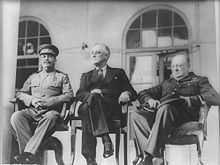 Soviet Premier Joseph Stalin, U.S. President Franklin D. Roosevelt and British Prime Minister Winston Churchill (left to right) confer in Tehran in 1943.
Soviet Premier Joseph Stalin, U.S. President Franklin D. Roosevelt and British Prime Minister Winston Churchill (left to right) confer in Tehran in 1943.
The same year, the USSR, in fulfillment of its agreement with the Allies at the Yalta Conference, denounced the Soviet–Japanese Neutrality Pact in April 1945[21] and invaded Manchukuo and other Japan-controlled territories on 9 August 1945.[22] This conflict ended with a decisive Soviet victory, contributing to the unconditional surrender of Japan and the end of World War II.
The Soviet Union suffered greatly in the war, losing around 27 million people.[23] Despite this, it emerged as a military superpower. Once denied diplomatic recognition by the Western world, the Soviet Union had official relations with practically every nation by the late 1940s. A member of the United Nations at its foundation in 1945, the Soviet Union became one of the five permanent members of the UN Security Council, which gave it the right to veto any of its resolutions (see Soviet Union and the United Nations).
The Soviet Union maintained its status as one of the world's two superpowers for four decades through its hegemony in Eastern Europe, military strength, economic strength, aid to developing countries, and scientific research, especially in space technology and weaponry.
Cold War
During the immediate postwar period, the Soviet Union rebuilt and expanded its economy, while maintaining its strictly centralized control. It aided post-war reconstruction in the countries of Eastern Europe, while turning them into satellite states, binding them in a military alliance (the Warsaw Pact) in 1955, and an economic organization (The Council for Mutual Economic Assistance or Comecon) from 1949 to 1991, the latter a counterpart to the European Economic Community.[24] Later, the Comecon supplied aid to the eventually victorious Chinese Communist Party, and saw its influence grow elsewhere in the world. Fearing its ambitions, the Soviet Union's wartime allies, the United Kingdom and the United States, became its enemies. In the ensuing Cold War, the two sides clashed indirectly using mostly proxies.
Khrushchev era
Main article: History of the Soviet Union (1953–1964)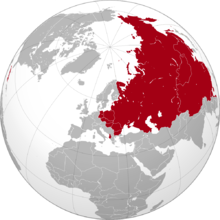 The maximum territorial extent of countries in the world under Soviet influence, after the Cuban Revolution of 1959 and before the official Sino–Soviet split of 1961
The maximum territorial extent of countries in the world under Soviet influence, after the Cuban Revolution of 1959 and before the official Sino–Soviet split of 1961
Stalin died on 5 March 1953. Without a mutually agreeable successor, the highest Communist Party officials opted to rule the Soviet Union jointly. Nikita Khrushchev, who had won the power struggle by the mid-1950s, denounced Stalin's use of repression in 1956 and eased repressive controls over party and society. This was known as de-Stalinization.
Moscow considered Eastern Europe to be a buffer zone for the forward defense of its western borders, and ensured its control of the region by transforming the East European countries into satellite states. Soviet military force was used to suppress anti-communist uprisings in Hungary and Poland in 1956.
In the late 1950s, a confrontation with China regarding the USSR's rapprochement with the West and what Mao Zedong perceived as Khrushchev's revisionism led to the Sino–Soviet split. This resulted in a break throughout the global Communist movement, with Communist regimes in Albania, Cambodia and Somalia choosing to ally with China in place of the USSR.
During this period, the Soviet Union continued to realize scientific and technological exploits: Launching the first artificial satellite, Sputnik 1; a living dog, Laika; the first human being, Yuri Gagarin; the first woman in space, Valentina Tereshkova in 1963; Alexey Leonov, the first person to walk in space in 1965; and the first moon rovers, Lunokhod 1 and Lunokhod 2.[25]
Khrushchev initiated "The Thaw" better known as Khrushchev's Thaw, a complex shift in political, cultural and economic life in the Soviet Union. That included some openness and contact with other nations and new social and economic policies with more emphasis on commodity goods, allowing living standards to rise dramatically while maintaining high levels of economic growth. Censorship was relaxed as well.
Khrushchev's reforms in agriculture and administration, however, were generally unproductive. In 1962, he precipitated a crisis with the United States over the Soviet deployment of nuclear missiles in Cuba. The Soviet Union backed down after the United States initiated a naval blockade, causing Khrushchev much embarrassment and loss of prestige. He was removed from power in 1964.
Brezhnev era
Following the ousting of Khrushchev, another period of collective leadership ensued, consisting of Leonid Brezhnev as General Secretary, Alexei Kosygin as Premier and Nikolai Podgorny as Chairman of the Presidium, lasting until Brezhnev established himself in the early 1970s as the preeminent Soviet leader. In 1968 the Soviet Union and its Warsaw Pact allies invaded Czechoslovakia to halt the Prague Spring reforms.
Brezhnev presided over a period of détente with the West (see SALT I, SALT II, Anti-Ballistic Missile Treaty) while at the same time building up Soviet military might.
In October 1977, the third Soviet Constitution was unanimously adopted. The prevailing mood of the Soviet leadership at the time of Brezhnev's death in 1982 was one of aversion to change. The long period of Brezhnev's rule had come to be dubbed one of "standstill", with an aging and ossified top political leadership.
Reforms and dissolution
Main articles: Cold War (1985–1991), History of the Soviet Union (1982–1991), Dissolution of the Soviet Union, 1991 Soviet coup d'état attempt, and Commonwealth of Independent StatesTwo developments dominated the decade that followed: the increasingly apparent crumbling of the Soviet Union's economic and political structures, and the patchwork attempts at reforms to reverse that process. Kenneth S. Deffeyes argued in Beyond Oil that the Reagan administration encouraged Saudi Arabia to lower the price of oil to the point where the Soviets could not make a profit selling their oil, so that the USSR's hard currency reserves became depleted.[26]
Brezhnev's next two successors, transitional figures with deep roots in his tradition, did not last long. Yuri Andropov was 68 years old and Konstantin Chernenko 72 when they assumed power; both died in less than two years. In an attempt to avoid a third short-lived leader, in 1985, the Soviets turned to the next generation and selected Mikhail Gorbachev.
Gorbachev made significant changes in the economy and party leadership, called perestroika. His policy of glasnost freed public access to information after decades of heavy government censorship.
Gorbachev also moved to end the Cold War. In 1988, the Soviet Union abandoned its nine-year war in Afghanistan and began to withdraw its forces. In the late 1980s, he refused military support to the Soviet Union's former satellite states, resulting in the toppling of multiple communist regimes. With the tearing down of the Berlin Wall and with East Germany and West Germany pursuing unification, the Iron Curtain came down.
In the late 1980s, the constituent republics of the Soviet Union started legal moves towards potentially declaring sovereignty over their territories, citing Article 72 of the USSR constitution, which stated that any constituent republic was free to secede.[27] On 7 April 1990, a law was passed allowing a republic to secede if more than two-thirds of its residents voted for it in a referendum.[28] Many held their first free elections in the Soviet era for their own national legislatures in 1990. Many of these legislatures proceeded to produce legislation contradicting the Union laws in what was known as the "War of Laws".
In 1989, the Russian SFSR, which was then the largest constituent republic (with about half of the population) convened a newly elected Congress of People's Deputies. Boris Yeltsin was elected its chairman. On 12 June 1990, the Congress declared Russia's sovereignty over its territory and proceeded to pass laws that attempted to supersede some of the USSR's laws. The period of legal uncertainty continued throughout 1991 as constituent republics slowly became de facto independent.
A referendum for the preservation of the USSR was held on 17 March 1991, with the majority of the population voting for preservation of the Union in nine out of the 15 republics. The referendum gave Gorbachev a minor boost. In the summer of 1991, the New Union Treaty, which would have turned the Soviet Union into a much looser federation, was agreed upon by eight republics.
The signing of the treaty, however, was interrupted by the August Coup—an attempted coup d'état by hardline members of the government and the KGB who sought to reverse Gorbachev's reforms and reassert the central government's control over the republics. After the coup collapsed, Yeltsin was seen as a hero for his decisive actions, while Gorbachev's power was effectively ended. The balance of power tipped significantly towards the republics. In August 1991, Latvia and Estonia immediately declared the restoration of their full independence (following Lithuania's 1990 example), while the other twelve republics continued discussing new, increasingly looser, models of the Union.
On 8 December 1991, the presidents of Russia, Ukraine and Belarus signed the Belavezha Accords, which declared the Soviet Union dissolved and established the Commonwealth of Independent States (CIS) in its place. While doubts remained over the authority of the accords to do this, on 21 December 1991, the representatives of all Soviet republics except Georgia signed the Alma-Ata Protocol, which confirmed the accords. On 25 December 1991, Gorbachev yielded to the inevitable and resigned as the President of the USSR, declaring the office extinct. He turned the powers that had been vested in the presidency over to Yeltsin, the President of Russia.
The following day, the Supreme Soviet, the highest governmental body of the Soviet Union, dissolved itself. This is generally recognized as marking the official, final dissolution of the Soviet Union as a functioning state. Many organizations, such as the Soviet Army and police forces, remained in place in the early months of 1992, but were slowly phased out and either withdrawn from or absorbed by the newly independent states.
Following the dissolution of the Soviet Union on 26 December 1991, Russia was internationally recognized[29] as its legal successor on the international stage. To that end, Russia voluntarily accepted all Soviet foreign debt and claimed overseas Soviet properties as its own. Since then, the Russian Federation has assumed the Soviet Union's rights and obligations.
Politics
There were three power hierarchies in the Soviet Union: the legislative branch represented by the Supreme Soviet of the Soviet Union, the government represented by the Council of Ministers, and the Communist Party of the Soviet Union (CPSU), the only legal party and the ultimate policymaker in the country.[30]
Communist Party
At the top of the Communist Party was the Central Committee, elected at Party Congresses and Conferences. The Central Committee in turn voted for a Politburo (called the Presidium between 1952–1966), Secretariat and the General Secretary (First Secretary from 1953 to 1966), the highest office in the USSR.[31] Depending on the degree of power consolidation, it was either the Politburo as a collective body or the General Secretary, who always was one of the Politburo members, that effectively led the party and the country[32] (except for the period of the highly personalized authority of Stalin, exercised directly through his position in the Council of Ministers rather than the Politburo after 1941).[33] They were not controlled by the general party membership, as the key principle of the party organization was democratic centralism, demanding strict subordination to higher bodies, and elections went uncontested, endorsing the candidates proposed from above.[34]
The Communist Party maintained its dominance over the state largely through its control over the system of appointments. All senior government officials and most deputies of the Supreme Soviet were members of the CPSU. Of the party heads themselves, Stalin in 1941–1953 and Khrushchev in 1958–1964 were Premiers. Upon the forced retirement of Khrushchev, the party leader was prohibited from this kind of double membership,[35] but the later General Secretaries for at least some part of their tenure occupied the largely ceremonial position of Chairman of the Presidium of the Supreme Soviet, the nominal head of state. The institutions at lower levels were overseen and at times supplanted by primary party organizations.[36]
In practice, however, the degree of control the party was able to exercise over the state bureaucracy, particularly after the death of Stalin, was far from total, with the bureaucracy pursuing different interests that were at times in conflict with the party.[37] Nor was the party itself monolithic from top to bottom, although factions were officially banned.[38]
Government
The Supreme Soviet (successor of the Congress of Soviets and Central Executive Committee) was nominally the highest state body for most of the Soviet history,[39] at first acting as a rubber stamp institution, approving and implementing all decisions made by the party. However, the powers and functions of the Supreme Soviet were extended in the late 1950s, 1960s and 1970s, including the creation of new state commissions and committees. It gained additional powers when it came to the approval of the Five-Year Plans and the Soviet state budget.[40] The Supreme Soviet elected a Presidium to wield its power between plenary sessions,[41] ordinarily held twice a year, and appointed the Supreme Court,[42] the Procurator General[43] and the Council of Ministers (known before 1946 as the Council of People's Commissars), headed by the Chairman (Premier) and managing an enormous bureaucracy responsible for the administration of the economy and society.[41] State and party structures of the constituent republics largely emulated the structure of the central institutions, although the Russian SFSR, unlike the other constituent republics, for most of its history had no republican branch of the CPSU, being ruled directly by the union-wide party until 1990. Local authorities were organized likewise into party committees, local Soviets and executive committees. While the state system was nominally federal, the party was unitary.[44]
The state security police (the KGB and its predecessor agencies) played an important role in Soviet politics. It was instrumental in the Stalinist terror,[45] but after the death of Stalin, the state security police was brought under strict party control. Under Yuri Andropov, KGB chairman in 1967–1982 and General Secretary from 1982 to 1983, the KGB engaged in the suppression of political dissent and maintained an extensive network of informers, reasserting itself as a political actor to some extent independent of the party-state structure,[46] culminating in the anti-corruption campaign targeting high party officials in the late 1970s and early 1980s.[47]
Separation of power and reform
The Soviet constitutions, which were promulgated in 1918, 1924, 1936 and 1977,[48] did not limit state power. No formal separation of powers existed between the Party, Supreme Soviet and Council of Ministers [49] that represented executive and legislative branches of the government. The system was governed less by statute than by informal conventions, and no settled mechanism of leadership succession existed. Bitter and at times deadly power struggles took place in the Politburo after the deaths of Lenin[50] and Joseph Stalin,[51] as well as after Khrushchev's dismissal,[52] itself due to a coup in both the Politburo and the Central Committee.[53] All Soviet party leaders before Gorbachev died in office, except Georgy Malenkov[54] and Khrushchev, both dismissed from the party leadership amid internal struggle within the party.[53]
In 1988–1990, facing considerable opposition, Mikhail Gorbachev enacted reforms shifting power away from the highest bodies of the party and making the Supreme Soviet less dependent on them. The Congress of People's Deputies was established, the majority of whose members were directly elected in competitive elections held in March 1989. The Congress now elected the Supreme Soviet, which became a full-time parliament, much stronger than before. For the first time since the 1920s, it refused to rubber stamp proposals from the party and Council of Ministers.[55] In 1990, Gorbachev introduced and assumed the position of the President of the Soviet Union, concentrated power in his executive office, independent of the party, and subordinated the government,[56] now renamed the Cabinet of Ministers of the USSR, to himself.[57]
Tensions grew between the union-wide authorities under Gorbachev, reformists led in Russia by Boris Yeltsin and controlling the newly elected Supreme Soviet of the Russian SFSR, and Communist Party hardliners. On 19–21 August 1991, a group of hardliners staged an abortive coup attempt. Following the failed coup, the State Council of the Soviet Union became the highest organ of state power "in the period of transition".[58] Gorbachev resigned as General Secretary, only remaining President for the final months of the existence of the USSR.[59]
Judicial system
The judiciary was not independent of the other branches of government. The Supreme Court supervised the lower courts (People's Court) and applied the law as established by the Constitution or as interpreted by the Supreme Soviet. The Constitutional Oversight Committee reviewed the constitutionality of laws and acts. The Soviet Union used the inquisitorial system of Roman law, where the judge, procurator, and defense attorney collaborate to establish the truth.[60]
Political divisions
Constitutionally, the Soviet Union was a union of Soviet Socialist Republics (SSRs) and the Russian Soviet Federative Socialist Republic (RSFSR), although the rule of the highly centralized Communist Party made the union merely nominal.[30] The Treaty on the Creation of the USSR was signed in December 1922 by four founding republics, the RSFSR, Transcaucasian SFSR, Ukrainian SSR and Belorussian SSR. In 1924, during the national delimitation in Central Asia, the Uzbek and Turkmen SSRs were formed from parts of the RSFSR's Turkestan ASSR and two Soviet dependencies, the Khorezm and Bukharan SSR. In 1929, the Tajik SSR was split off from the Uzbek SSR. With the constitution of 1936, the constituents of the Transcaucasian SFSR, namely the Georgian, Armenian and Azerbaijan SSRs, were elevated to union republics, while the Kazakh and Kirghiz SSRs were split off from the RSFSR.[61] In August 1940, the Soviet Union formed the Moldavian SSR from parts of the Ukrainian SSR and parts of Bessarabia annexed from Romania. It also annexed the Baltic states as the Estonian, Latvian and Lithuanian SSRs. The Karelo-Finnish SSR was split off from the RSFSR in March 1940 and merged back in 1956. Between July 1956 and September 1991, there were 15 union republics (see map below).[62]
On 16 November 1988, the Supreme Soviet of the Estonian SSR passed the Estonian Sovereignty Declaration that asserted Estonia's sovereignty and declared the supremacy of Estonian laws over those of the Soviet Union.[63] In March 1990, the newly elected Supreme Soviet of the Lithuanian SSR declared independence, followed by the Georgian Supreme Soviet in April 1991. Although the symbolic right of the republics to secede was nominally guaranteed by the constitution and the union treaty,[30] Soviet authorities at first refused to recognize it. After the August coup attempt, most of the other republics followed suit. The Soviet Union ultimately recognized the secession of Estonia, Latvia and Lithuania on 6 September 1991. The remaining republics were recognized as independent with the Soviet Union's final dissolution in December 1991.[64]
Economy
The Soviet Union became the first country to adopt a planned economy, whereby production and distribution of goods were centralized and directed by the government. The first Bolshevik experience with a command economy was the policy of War Communism, which involved nationalization of industry, centralized distribution of output, coercive requisition of agricultural production, and attempts to eliminate the circulation of money, as well as private enterprises and free trade. As it had aggravated a severe economic collapse caused by the war, in 1921, Lenin replaced War Communism with the New Economic Policy (NEP), legalizing free trade and private ownership of smaller businesses. The economy quickly recovered.[65]
Following a lengthy debate among the members of Politburo over the course of economic development, by 1928–1929, upon gaining control of the country, Joseph Stalin abandoned the NEP and pushed for full central planning, starting forced collectivization of agriculture and enacting draconian labor legislation. Resources were mobilized for rapid industrialization, which greatly expanded Soviet capacity in heavy industry and capital goods during the 1930s.[65] Preparation for war was one of the main driving forces behind industrialization, mostly due to distrust of the outside capitalistic world.[66] As a result, the USSR was transformed from a largely agrarian economy into a great industrial power, leading the way for its emergence as a superpower after World War II.[67] During the war, the Soviet economy and infrastructure suffered massive devastation and required extensive reconstruction.[68]
By the early 1940s, the Soviet economy had become relatively self-sufficient; for most of the period until the creation of Comecon, only a very small share of domestic products was traded internationally.[69] After the creation of the Eastern Bloc, external trade rose rapidly. Still the influence of the world economy on the USSR was limited by fixed domestic prices and a state monopoly on foreign trade.[70] Grain and sophisticated consumer manufactures became major import articles from around the 1960s.[69] During the arms race of the Cold War, the Soviet economy was burdened by military expenditures, heavily lobbied for by a powerful bureaucracy dependent on the arms industry. At the same time, the Soviet Union became the largest arms exporter to the Third World. Significant amounts of Soviet resources during the Cold War were allocated in aid to the other socialist states.[69]
From the 1930s until its collapse in the late 1980s, the way the Soviet economy operated remained essentially unchanged. The economy was formally directed by central planning, carried out by Gosplan and organized in five-year plans. In practice, however, the plans were highly aggregated and provisional, subject to ad hoc intervention by superiors. All key economic decisions were taken by the political leadership. Allocated resources and plan targets were normally denominated in rubles rather than in physical goods. Credit was discouraged, but widespread. Final allocation of output was achieved through relatively decentralized, unplanned contracting. Although in theory prices were legally set from above, in practice the actual prices were often negotiated, and informal horizontal links[clarification needed] were widespread.[65]
A number of basic services were state-funded, such as education and healthcare. In the manufacturing sector, heavy industry and defense were assigned higher priority than the production of consumer goods.[71] Consumer goods, particularly outside large cities, were often scarce, of poor quality and limited choice. Under command economy, consumers had almost no influence over production, so the changing demands of a population with growing incomes could not be satisfied by supplies at rigidly fixed prices.[72] A massive unplanned second economy grew up alongside the planned one at low levels, providing some of the goods and services that the planners could not. Legalization of some elements of the decentralized economy was attempted with the reform of 1965.[65]
Although statistics of the Soviet economy are notoriously unreliable and its economic growth difficult to estimate precisely,[73][74] by most accounts, the economy continued to expand until the mid 1980s. During the 1950s and 1960s, the Soviet economy experienced comparatively high growth and was catching up to the West.[75] However, after 1970, the growth, while still positive, steadily declined, much more quickly and consistently than in other countries, despite a rapid increase in the capital stock, (the rate of increase in capital was only surpassed by Japan).[65]
Overall, between 1960 and 1989, the growth rate of per capita income in the Soviet Union was slightly above the world average (based on 102 countries). However, given the very high level of investment in physical capital, high percentage of people with a secondary education, and low population increase, the economy should have grown much faster. According to Stanley Fischer and William Easterly, the Soviet growth record was among "the worst in the world". By their calculation, per capita income of Soviet Union in 1989 should have been twice as high as it was, if investment, education and population had their typical effect on growth. The authors attribute this poor performance to low productivity of capital in the Soviet Union.[76]
In 1987, Mikhail Gorbachev tried to reform and revitalize the economy with his program of perestroika. His policies relaxed state control over enterprises, but did not yet allow it to be replaced by market incentives, ultimately resulting in a sharp decline in production output. The economy, already suffering from reduced petroleum export revenues, started to collapse. Prices were still fixed, and property was still largely state-owned until after the dissolution of the Soviet Union.[65][72] For most of the period after World War II up to its collapse, the Soviet economy was the second largest in the world by GDP (PPP),[77] though in per capita terms the Soviet GDP was behind that of the First World countries.[78]
Energy
Main article: Energy policy of the Soviet UnionThe need for fuel declined in the Soviet Union from the 1970s to the 1980s,[79] both per ruble of gross social product and per ruble of industrial product. At the start, this decline grew very rapidly, but gradually slowed down between 1970 and 1975. From 1975 and 1980, it grew even slower,[clarification needed] only 2.6 percent.[80] David Wilson, a historian, believed that the gas industry would account for 40 percent of Soviet fuel production by the end of the century. His theory did not come to fruition because of the USSR's collapse.[81] The USSR, in theory, would have continued to have an economic growth rate of 2–2.5 percent during the 1990s because of Soviet energy fields[clarification needed].[82] However, the energy sector faced many difficulties, among them the country's high military expenditure and hostile relations with the First World (pre-Gorbachev era).[83]
In 1991, the Soviet Union had a pipeline network of 82,000 kilometres (51,000 mi) for crude oil and another 206,500 kilometres (128,300 mi) for natural gas.[84] Petroleum and petroleum-based products, natural gas, metals, wood, agricultural products, and a variety of manufactured goods, primarily machinery, arms and military equipment, were exported.[85] In the 1970s and 1980s, the Soviet Union heavily relied on fossil fuel exports to earn hard currency.[69] At its peak in 1988, it was the largest producer and second largest exporter of crude oil, surpassed only by Saudi Arabia.[86]
Science and technology
The Soviet Union placed great emphasis on science and technology within its economy,[87] however, the most remarkable Soviet successes in technology, such as producing the world's first space satellite, typically were the responsibility of the military.[71] Lenin believed that the USSR would never overtake the developed world if it remained as technologically backward as it was. Soviet authorities proved their commitment to Lenin's belief by developing massive networks, research and development organizations. By 1989, Soviet scientists were among the world's best-trained specialists in several areas, such as energy physics, selected areas of medicine, mathematics, welding and military technologies. Due to rigid state planning and bureaucracy, the Soviets remained far behind technologically in chemistry, biology, and computers when compared to the First World.
Project Socrates, under the Reagan administration, determined that the Soviet Union addressed the acquisition of science and technology in a manner that was radically different from what the US was using. In the case of the US, economic prioritization was being used for indigenous research and development as the means to acquire science and technology in both the private and public sectors. In contrast, the Soviet Union was offensively and defensively maneuvering in the acquisition and utilization of the worldwide technology, to increase the competitive advantage that they acquired from the technology, while preventing the US from acquiring a competitive advantage. However, in addition, the Soviet Union's technology-based planning was executed in a centralized, government-centric manner that greatly hindered its flexibility. It was this significant lack of flexibility that was exploited by the US to undermine the strength of the Soviet Union and thus foster its reform. [88][89][90]
Transport
Main article: Transport in the Soviet UnionTransport was a key component of the nation's economy. The economic centralisation of the late 1920s and 1930s led to the development of infrastructure on a massive scale, most notably the establishment of Aeroflot, an aviation enterprise.[91] The country had a wide variety of modes of transport by land, water and air.[84] However, due to bad maintenance, much of the road, water and Soviet civil aviation transport were outdated and technologically backward compared to the First World.[92]
Soviet rail transport was the largest and most intensively used in the world;[92] it was also better developed than most of its Western counterparts.[93] By the late 1970s and early 1980s, Soviet economists were calling for the construction of more roads to alleviate some of the burden from the railways and to improve the Soviet state budget.[94] The road network and automobile industry[95] remained underdeveloped,[96] and dirt roads were common outside major cities.[97] Soviet maintenance projects proved unable to take care of even the few roads the country had. By the early to mid-1980s, the Soviet authorities tried to solve the road problem by ordering the construction of new ones.[97] Meanwhile, the automobile industry was growing at a faster rate than road construction.[98] The underdeveloped road network led to a growing demand for public transport.[99]
Despite improvements, several aspects of the transport sector were still riddled with problems due to outdated infrastructure, lack of investment, corruption and bad decision-making. Soviet authorities were unable to meet the growing demand for transport infrastructure and services.
The Soviet merchant fleet was one of the largest in the world.[84]
Demographics
The first fifty years of the 20th century in tsarist Russia and the Soviet Union were marked by a succession of disasters, each accompanied by large–scale population losses. Excess deaths over the course of World War I and the Russian Civil War (including the postwar famine) amounted to a combined total of 18 million,[100] some 10 million in the 1930s,[18] and more than 26 million in 1941–5. The postwar Soviet population was 45 to 50 million smaller than it would have been if pre-war demographic growth had continued.[101]
The crude birth rate of the USSR decreased from 44.0 per thousand in 1926 to 18.0 in 1974, largely due to increasing urbanization and the rising average age of marriages. The crude death rate demonstrated a gradual decrease as well – from 23.7 per thousand in 1926 to 8.7 in 1974. In general, the birth rates of the southern republics in Transcaucasia and Central Asia were considerably higher than those in the northern parts of the Soviet Union, and in some cases even increased in the post–World War II period, a phenomenon partly attributed to slower rates of urbanization and traditionally earlier marriages in the southern republics.[102] Soviet Europe moved towards sub-replacement fertility, while Soviet Central Asia continued to exhibit population growth well above replacement-level fertility.[103]
The late 1960s and the 1970s witnessed a reversal of the declining trajectory of the rate of mortality in the USSR, and was especially notable among men of working age, but was also prevalent in Russia and other predominantly Slavic areas of the country.[104] An analysis of the official data from the late 1980s showed that after worsening in the late-1970s and the early 1980s, adult mortality began to improve again.[105] The infant mortality rate increased from 24.7 in 1970 to 27.9 in 1974. Some researchers regarded the rise as largely real, a consequence of worsening health conditions and services.[106] The rises in both adult and infant mortality were not explained or defended by Soviet officials, and the Soviet government simply stopped publishing all mortality statistics for ten years. Soviet demographers and health specialists remained silent about the mortality increases until the late-1980s, when the publication of mortality data resumed and researchers could delve into the real causes.[107]
Education
Before 1917, education was not free in the Russian Empire and was therefore either inaccessible or barely accessible for many children from lower-class working and peasant families. Estimates from 1917 recorded that 75–85 percent of the Russian population was illiterate.
Anatoly Lunacharsky became the first People's Commissariat for Education of Soviet Russia. At the beginning, the Soviet authorities placed great emphasis on the elimination of illiteracy. People who were literate were automatically hired as teachers. For a short period, quality was sacrificed for quantity. By 1940, Joseph Stalin could announce that illiteracy had been eliminated. In the aftermath of the Great Patriotic War, the country's educational system expanded dramatically. This expansion had a tremendous effect. In the 1960s, nearly all Soviet children had access to education, the only exception being those living in remote areas. Nikita Khrushchev tried to make education more accessible, making it clear to children that education was closely linked to the needs of society. Education also became important in creating the New Soviet Man.[108]
Access to higher education was restricted, however; only 20 percent of all applicants were accepted. The rest entered the labor market or learned a skill at a vocational technical school or technicum[dubious ]. Students from families of dubious political reliability were barred from higher education.[109] The Brezhnev administration introduced a rule that required all university applicants to present a reference from the local Komsomol party secretary.[110] According to statistics from 1986, the number of students per 10,000 population was 181 for the USSR, compared to 517 for the US.[111]
Ethnic groups
The Soviet Union was a very ethnically diverse country, with more than 100 distinct ethnic groups. The total population was estimated at 293 million in 1991. According to a 1990 estimate, the majority were Russians (50.78%), followed by Ukrainians (15.45%) and Uzbeks (5.84%).[112]
All citizens of the USSR had their own ethnic affiliation. The ethnicity of a person was chosen at the age of sixteen[113] by the child's parents. If the parents did not agree, the child was automatically assigned the ethnicity of the mother. Partly due to Soviet policies, some of the smaller minority ethnic groups were considered part of larger ones, such as the Mingrelians of the Georgian SSR, who were classified with the linguistically related Georgians.[114] Some ethnic groups voluntarily assimilated, while others were brought in by force. Russians, Belarusians, and Ukrainians shared close cultural ties, while other groups did not. With multiple nationalities living in the same territory, ethnic antagonisms developed over the years.[115]
Health
In 1917, before the Bolshevik uprising, health conditions were significantly behind the developed countries. As Lenin later noted, "Either the lice will defeat socialism, or socialism will defeat the lice".[116] The Soviet principle of health care was conceived by the People's Commissariat for Health in 1918. Health care was to be controlled by the state and would be provided to its citizens free of charge. Article 42 of the 1977 Soviet Constitution gave all citizens the right to health protection and free access to any health institutions in the USSR. However, the Soviet Union's health care system was not able to fulfill all the needs of its people.[117] Before Leonid Brezhnev rose to power, Soviet socialised medicine was held in high esteem by many foreign specialists. This changed however, from Brezhnev's accession and Mikhail Gorbachev's tenure as leader, the Soviet health care system was heavily criticised for many basic faults, such as the quality of service and the unevenness in its provision.[118] Minister of Health Yevgeniy Chazov, during the 19th Congress of the Communist Party of the Soviet Union, while highlighting such Soviet success as having the most doctors and hospitals in the world, recognised the system's deficiencies and felt that billions of Soviet rubles were squandered.[119]
After the communist takeover, the life expectancy for all age groups went up. This statistic was used by authorities to prove that the socialist system was superior to the capitalist system. These improvements continued into the 1960s, when the life expectancy in the Soviet Union surpassed that of the United States. It remained stable during most years, although in the 1970s, it went down slightly, probably because of alcohol abuse. Most western sources put the blame on growing alcohol abuse and poor health care; this theory was also implicitly accepted by the Soviet authorities. At the same time, infant mortality began to rise. After 1974, the government stopped publishing statistics on this. This trend can be partly explained by the number of pregnancies rising drastically in the Asian part of the country where infant mortality was highest, while declining markedly in the more developed European part of the Soviet Union.[120]
Language
The Soviet government headed by Vladimir Lenin gave small language groups their own writing systems.[121] The development of these writing systems was very successful, even though some flaws were detected. During the later days of the USSR, countries with the same multilingual situation implemented similar policies. A serious problem when creating these writing systems was that the languages differed dialectally greatly from each other.[122] When a language had been given a writing system and appeared in a notable publication, that language would attain "official language" status. There were many minority languages which never received their own writing system; therefore their speakers were forced to have a second language.[123] There are examples where the Soviet government retreated from this policy, most notable under Stalin's regime, where education was discontinued in languages which were not widespread enough. These languages were then assimilated into another language, mostly Russian.[124] During the Great Patriotic War (World War II), some minority languages were banned, and their speakers accused of collaborating with the enemy.[125]
As the most widely spoken of the Soviet Union's many languages, Russian de facto functioned as an official language as the "language of interethnic communication" (Russian: язык межнационального общения), but only assumed the de jure status of the official national language in 1990.[126]
Religion
A.L. Eliseev writes that a meeting of the antireligious commission of the Central Committee of the All-Union Communist Party (Bolsheviks) took place on 23 May 1929 under the Chairmanship of E. laroslavskii. There, believers in the country were estimated at 80 percent. It cannot be ruled out that this percentage was somewhat understated, to prove the successfulness of the struggle with religion[127]
Christianity and Islam had the greatest number of adherents among the Soviet state's religious citizens.[128] Eastern Christianity predominated among Christians, with Russia's traditional Russian Orthodox Church being the Soviet Union's largest Christian denomination. About 90 percent of the Soviet Union's Muslims were Sunnis, with Shiites concentrated in the Azerbaijani Soviet Socialist Republic.[128] Smaller groups included Roman Catholics, Jews, Buddhists, and a variety of Protestant sects.[128]
Religious influence had been strong in the Russian Empire. The Russian Orthodox Church enjoyed a privileged status as the church of the monarchy and took part in carrying out official state functions.[129] The immediate period following the establishment of the Soviet state included a struggle against the Orthodox Church, which the revolutionaries considered an ally of the former ruling classes.[130]
In Soviet law, the "freedom to hold religious services" was constitutionally guaranteed, although the ruling Communist Party regarded religion as incompatible with the Marxist spirit of scientific materialism.[130] In practice, the Soviet system subscribed to a narrow interpretation of this right, and in fact utilized a range of official measures to discourage religion and curb the activities of religious groups.[130]
The 1918 Council of People's Commissars decree establishing the Russian Soviet Federative Socialist Republic (RSFSR) as a secular state also decreed that "the teaching of religion in all [places] where subjects of general instruction are taught, is forbidden. Citizens may teach and may be taught religion privately."[131] Among further restrictions, those adopted in 1929, a half-decade into Stalin's rule, included express prohibitions on a range of church activities, including meetings for organized Bible study.[130] Both Christian and non-Christian establishments were shut down by the thousands in the 1920s and 1930s. By 1940, as many as 90 percent of the churches, synagogues, and mosques that had been operating in 1917 were closed.[132]
Convinced that religious anti-Sovietism had become a thing of the past, the Stalin regime began shifting to a more moderate religion policy in the late 1930s.[133] Soviet religious establishments overwhelmingly rallied to support the war effort during the Soviet war with Nazi Germany. Amid other accommodations to religious faith, churches were reopened, Radio Moscow began broadcasting a religious hour, and a historic meeting between Stalin and Orthodox Church leader Patriarch Sergius I of Moscow was held in 1943.[133] The general tendency of this period was an increase in religious activity among believers of all faiths.[134]
The Soviet establishment again clashed with the churches under General Secretary Nikita Khrushchev's leadership in 1958 – 1964, a period when atheism was emphasized in the educational curriculum, and numerous state publications promoted atheistic views.[133] During this period, the number of churches fell from 20,000 to 10,000 from 1959 to 1965, and the number of synagogues dropped from 500 to 97.[135] The number of working mosques also declined, falling from 1,500 to 500 within a decade.[135]
Religious institutions remained monitored by the Soviet government, but churches, synagogues, temples, and mosques were all given more leeway in the Brezhnev era.[136] Official relations between the Orthodox Church and the Soviet government again warmed to the point that the Brezhnev government twice honored Orthodox Patriarch Alexey II with Soviet decorations, including the Order of the Red Banner of Labor.[133] A poll conducted by Soviet authorities in 1982 recorded 20 percent of the Soviet population as "active religious believers."[137]
Culture
The culture of the Soviet Union passed through several stages during the USSR's 70-year existence. During the first eleven years following the Revolution (1918–1929), there was relative freedom and artists experimented with several different styles to find a distinctive Soviet style of art. Lenin wanted art to be accessible to the Russian people. On the other hand, hundreds of intellectuals, writers, and artists were exiled or executed, and their work banned, for example Nikolay Gumilev (shot for conspiring against the Bolshevik regime) and Yevgeny Zamyatin (banned).[138]
The government encouraged a variety of trends. In art and literature, numerous schools, some traditional and others radically experimental, proliferated. Communist writers Maksim Gorky and Vladimir Mayakovsky were active during this time. Film, as a means of influencing a largely illiterate society, received encouragement from the state; much of director Sergei Eisenstein's best work dates from this period.
Later, during Stalin's rule, Soviet culture was characterised by the rise and domination of the government-imposed style of socialist realism, with all other trends being severely repressed, with rare exceptions, for example Mikhail Bulgakov's works. Many writers were imprisoned and killed.[139]
Following the Khrushchev Thaw of the late 1950s and early 1960s, censorship was diminished. Greater experimentation in art forms were again permissible, with the result that more sophisticated and subtly critical work began to be produced. The regime loosened its emphasis on socialist realism; thus, for instance, many protagonists of the novels of author Yury Trifonov concerned themselves with problems of daily life rather than with building socialism. An underground dissident literature, known as samizdat, developed during this late period. In architecture the Khrushchev era mostly focused on functional design as opposed to the highly decorated style of Stalin's epoch.
In the second half of the 1980s, Gorbachev's policies of perestroika and glasnost significantly expanded freedom of expression in the media and press.[140]
See also
- Evil empire
- Index of Soviet Union-related articles
References
- ^ Bridget O'Laughlin (1975) Marxist Approaches in Anthropology Annual Review of Anthropology Vol. 4: pp. 341–70 (October 1975) (doi:10.1146/annurev.an.04.100175.002013).
William Roseberry (1997) Marx and Anthropology Annual Review of Anthropology, Vol. 26: pp. 25–46 (October 1997) (doi:10.1146/annurev.anthro.26.1.25) - ^ a b Robert Service (2005-09-09). Stalin: a biography. Picador. ISBN 978-0-330-41913-0. http://books.google.com/?id=ITKUPwAACAAJ.
- ^ Crile, George (2003-04-21). Charlie Wilson's War: The Extraordinary Story of the Largest Covert Operation in History. Atlantic Monthly Press. ISBN 978-0-87113-854-5. http://books.google.com/?id=juBxr41_c64C.
- ^ Mr. David Holloway (1996-03-27). Stalin and the Bomb. Yale University Press. p. 18. ISBN 978-0-300-06664-7. http://yalepress.yale.edu/book.asp?isbn=9780300066647.
- ^ Turner 1987, p. 23
- ^ Iain McLean (1996). The concise Oxford dictionary of politics. Oxford University Press. ISBN 978-0-19-285288-5. http://books.google.com/?id=UMuBAAAAMAAJ.
- ^ "Russia is now a party to any Treaties to which the former Soviet Union was a party, and enjoys the same rights and obligations as the former Soviet Union, except insofar as adjustments are necessarily required, e.g. to take account of the change in territorial extent. [...] The Russian federation continues the legal personality of the former Soviet Union and is thus not a successor State in the sense just mentioned. The other former Soviet Republics are successor States.", United Kingdom Materials on International Law 1993, BYIL 1993, pp. 579 (636).
- ^ Evan Mawdsley (2007-03-01). The Russian Civil War. Pegasus Books. p. 287. ISBN 978-1-933648-15-6. http://books.google.com/?id=LUhXZD2BPeQC&pg=PA287.
- ^ Richard Sakwa The Rise and Fall of the Soviet Union, 1917–1991: 1917–1991. Routledge, 1999. ISBN 978–0–415–12290–2, 9780415122900. pp. 140–143.
- ^ Julian Towster. Political Power in the U.S.S.R., 1917–1947: The Theory and Structure of Government in the Soviet State Oxford Univ. Press, 1948. p. 106.
- ^ (Russian) Voted Unanimously for the Union. Archived July 22, 2011 at the Wayback Machine
- ^ (Russian) Creation of the USSR at Khronos.ru.[dead link]
- ^ "70 Years of Gidroproekt and Hydroelectric Power in Russia". http://www.springerlink.com/content/h3677572g016338u/.[dead link]
- ^ (Russian) On GOELRO Plan — at Kuzbassenergo. Archived July 23, 2011 at the Wayback Machine
- ^ The consolidation into a single-party regime took place during the first three and a half years after the revolution, which included the period of War Communism and an election in which multiple parties competed. See Leonard Schapiro, The Origin of the Communist Autocracy: Political Opposition in the Soviet State, First Phase 1917–1922. Cambridge, MA: Harvard University Press, 1955, 1966.
- ^ Stéphane Courtois; Mark Kramer (1999-10-15). Livre noir du Communisme: crimes, terreur, répression. Harvard University Press. p. 206. ISBN 978-0-674-07608-2. http://books.google.com/?id=H1jsgYCoRioC&pg=PA206.
- ^ Abbott Gleason (2009). A companion to Russian history. Wiley-Blackwell. p. 373. ISBN 978-1-4051-3560-3. http://books.google.com/?id=JyN0hlKcfTcC&pg=PA373.
- ^ a b Geoffrey A. Hosking (2001). Russia and the Russians: a history. Harvard University Press. p. 469. ISBN 978-0-674-00473-3. http://books.google.com/?id=oh-5AAmboMUC&pg=PA469.
- ^ (Russian) Mel'tiukhov, Mikhail. Upushchennyi shans Stalina: Sovietskii Soiuz i bor'ba za Evropu 1939–1941. Moscow: Veche, 2000. ISBN 978–5–7838–1196–3.
- ^ William J. Duiker (2009-08-31). Contemporary World History. Wadsworth Pub Co. p. 128. ISBN 978-0-495-57271-8. http://books.google.com/?id=uqvgYtJHGSMC.
- ^ Denunciation of the neutrality pact 5 April 1945. (Avalon Project at Yale University)
- ^ Soviet Declaration of War on Japan, 8 August 1945. (Avalon Project at Yale University)
- ^ Geoffrey A. Hosking (2006). Rulers and victims: the Russians in the Soviet Union. Harvard University Press. p. 242. ISBN 978-0-674-02178-5. http://books.google.com/?id=CDMVMqDvp4QC&pg=PA242.
- ^ "Main Intelligence Administration (GRU) Glavnoye Razvedovatel'noye Upravlenie – Russia / Soviet Intelligence Agencies". Fas.org. http://www.fas.org/irp/world/russia/gru/. Retrieved 2008-11-24.
- ^ "Tank on the Moon". The Nature of Things with David Suzuki. CBC-TV. December 6, 2007.
- ^ Kenneth S. Deffeyes, Beyond Oil: The View from Hubbert's Peak.
- ^ The red blues — Soviet politics by Brian Crozier, National Review, 25 June 1990. Archived June 28, 2011 at the Wayback Machine
- ^ Origins of Moral-Ethical Crisis and Ways to Overcome it by V.A.Drozhin Honoured Lawyer of Russia.
- ^ Country Profile: Russia Foreign & Commonwealth Office of the United Kingdom.
- ^ a b c Sakwa, Richard. Soviet Politics in Perspective. 2nd ed. London – N.Y.: Routledge, 1998.
- ^ Law, David A. (1975). Russian Civilization. Ardent Media. pp. 193–94. ISBN 978–0842205292. http://books.google.com/books?id=f3ky9qBavl4C&dq.
- ^ Zemtsov, Ilya (1989). Chernenko: The Last Bolshevik: The Soviet Union on the Eve of Perestroika. Transaction Publishers. p. 325. ISBN 978–0887382606. http://books.google.com/books?id=hgscfLr5dCsC&dq.
- ^ Knight, Amy (1995). Beria: Stalin's First Lieutenant. Princeton University Press. p. 5. ISBN 978–0691010935. http://books.google.com/books?id=PxiuUGRQhUIC&dq.
- ^ Hough, Jerry F.; Fainsod, Merle (1979). How the Soviet Union is Governed. Harvard University Press. p. 486. ISBN 978–0674410300. http://books.google.com/books?id=38gMzMRXCpQC&dq.
- ^ Service, Robert (2009). History of Modern Russia: From Tsarism to the Twenty-first Century. Penguin Books Ltd. p. 378. ISBN 978–0141037970. http://books.google.com/books?id=o8Z1QAAACAAJ&dq.
- ^ Конститутион оф тхе Руссиян Федератион: витх комментариес анд интерпретатион. Brunswick Publishing Corp. 1994. p. 82. ISBN 978–1556181426. http://books.google.com/books?id=3mQjvzP8VSYC&dq.
- ^ Ōgushi, Atsushi (2008). The Demise of the Soviet Communist Party. Routledge. pp. 31–32. ISBN 978–0415434394. http://books.google.com/books?id=N7mDUC1nOZsC&dq.
- ^ Taras, Ray (1989). Leadership change in Communist states. Routledge. p. 132. ISBN 978–0044452772. http://books.google.com/books?id=AlcVAAAAIAAJ&dq.
- ^ F. Triska, Jan; Slusser, Robert M. (1962). The Theory, Law, and Policy of Soviet Treaties. Stanford University Press. pp. 63–64. ISBN 978–0804701229. http://books.google.com/books?id=QmWmAAAAIAAJ&dq.
- ^ Deb, Kalipada (1996). Soviet Union to Commonwealth: Transformation and Challenges. M.D. Publications Pvt. Ltd. p. 81. ISBN 978–8185880956. http://books.google.com/books?id=IvK6r-8Ogg0C&dq.
- ^ a b Benson, Shirley (2001). Nikita Khrushchev and the Creation of a Superpower. Penn State University Press. pp. XIV. ISBN 978–0271021705. http://books.google.com/books?id=dQeahlZdM7sC&dq.
- ^ The Communist World. Ardent Media. 2001. p. 441. ISBN 978–0271021705. http://books.google.com/books?id=h9FFVgu-Ff0C&dq.
- ^ Joseph Marie Feldbrugge, Ferdinand (1993). Russian Law: The End of the Soviet System and the Role of Law. Martinus Nijhoff Publishers. p. 205. ISBN 978–0792323580. http://books.google.com/books?id=JWt7MN3Dch8C&dq.
- ^ White, Stephen; J. Gill, Graeme; Slider, Darrell (1993). The Politics of Transition: Shaping a post-Soviet Future. Cambridge University Press. p. 108. ISBN 978–0521446341. http://books.google.com/books?id=O9IGbITqT_EC&dq.
- ^ P. Hoffmann, Erik; Laird, Robin Frederick (1984). The Soviet Polity in the Modern Era. Transaction Publishers. pp. 313–315. ISBN 978–0202241653. http://books.google.com/books?id=63_obglArrMC&dq.
- ^ P. Hoffmann, Erik; Laird, Robin Frederick (1984). The Soviet Polity in the Modern Era. Transaction Publishers. pp. 315–319. ISBN 978–0202241653. http://books.google.com/books?id=63_obglArrMC&dq.
- ^ "The Soviet Polity in the Modern Era". Great Russian Encyclopedia. Bol'shaya Rossiyskaya Enciklopediya Publisher. 2005. p. 742.
- ^ Sakwa, Richard (1998). Soviet Politics in Perspective. Routledge. p. 106. ISBN 978–0415071534. http://books.google.com/books?id=vX1U5G_xnqcC&dq.
- ^ Kucherov, Samuel (1970). The Organs of Soviet Administration of Justice: Their History and Operation. Brill Archive Publishers. p. 31. http://books.google.com/books?id=ssMUAAAAIAAJ&dq.
- ^ Phillips, Steve (2000). Lenin and the Russian Revolution. Heinemann. p. 71. ISBN 978–0435327194. http://books.google.com/books?id=_na0zfdhKQMC&dq.
- ^ Encyclopædia Britannica (2005). Union of Soviet Socialist Republics. Encyclopædia Britannica, Inc.. p. 1014.
- ^ Service, Robert (2009). History of Modern Russia: From Tsarism to the Twenty-first Century. Penguin Books Ltd. p. 379. ISBN 978–0141037970. http://books.google.com/books?id=o8Z1QAAACAAJ&dq.
- ^ a b Khrushchev, Nikita (2007). Memoirs of Nikita Khrushchev, Volume 3: Statesman. Pennsylvania State University Press. p. 674. ISBN 978–0271029351.
- ^ Polley, Martin (2000). A–Z of modern Europe since 1789. Routledge. p. 88. ISBN 978–0415185971. http://books.google.com/books?id=_f8Avd5N5Y4C&dq.
- ^ "Gorbachev's Reform Dilemma". Library of Congress Country Studies. http://countrystudies.us/russia/18.htm. Retrieved 16 October 2010.
- ^ Polmar, Norman (1991). The Naval Institute Guide to the Soviet. United States Naval Institute. p. 1. ISBN 978–0870212419. http://books.google.ca/books?id=tkGDkpkQh-sC&dq.
- ^ McCauley, Martin (2007). The Rise and Fall of the Soviet Union. Pearson Education. p. 490. ISBN 978–0582784654. http://books.google.ca/books?id=ycCZqmhhceMC&dq.
- ^ Government of the USSR: Gorbachev, Mikhail (21 March 1972). "УКАЗ: ПОЛОЖЕНИЕ О МИНИСТЕРСТВЕ ЮСТИЦИИ СССР [Law: About state governing bodies of USSR in a transition period On the bodies of state authority and administration of the USSR in Transition]" (in Russian). sssr.su. http://www.sssr.su/zopp.html. Retrieved 15 October 1991.
- ^ Vincent Daniels, Robert (1993). A Documentary History of Communism in Russia: From Lenin to Gorbachev. University Press of New England (UPNE). p. 388. ISBN 978–0874516161. http://books.google.com/books?id=gTIZ2dvDKF0C&dq.
- ^ Encyclopædia Britannica. "Inquisitorial procedure (law) – Britannica Online Encyclopedia". Encyclopædia Britannica, Inc.. http://www.britannica.com/EBchecked/topic/288956/inquisitorial-procedure. Retrieved 30 October 2010.
- ^ Adams, Simon (2005). Russian Republics. Black Rabbit Books. p. 21. ISBN 978–1583406069. http://books.google.com/books?id=LyqIDCc-cSsC&dq.
- ^ Feldbrugge, Ferdinand Joseph Maria (1993). Russian Law: The Rnd of the Soviet system and the Role of Law. Martinus Nijhoff Publishers. p. 94. ISBN 978–0792323580. http://books.google.com/books?id=JWt7MN3Dch8C&dq.
- ^ Walker, Edward (2003-06). Dissolution. Rowman & Littlefield. p. 63. ISBN 978-0-7425-2453-8. http://books.google.com/?id=Y06eqVKtfQgC.
- ^ Hughes, James; Sasse, Gwendolyn (2002). Ethnicity and Territory in the former Soviet Union: Regions in Conflict. Routledge. pp. 63 and 146. ISBN 978–0714652261. http://books.google.com/books?id=7vjb-0eZ-wcC&dq.
- ^ a b c d e f Gregory, Paul R. (2004). The Political Economy of Stalinism: Evidence from the Soviet Secret Archives. Cambridge University Press. pp. 218–20. ISBN 978–0521533678. http://books.google.com/books?id=hFHU5kaXhu8C&dq.
- ^ Mawdsley, Evan (1998). The Stalin Years: The Soviet Union, 1929–1953. Manchester University Press. p. 30. ISBN 978–0719046009. http://books.google.com/?id=m-voAAAAIAAJ&dq.
- ^ Wheatcroft, S. G.; Davies, R. W.; Cooper, J. M. (1986). Soviet Industrialization Reconsidered: Some Preliminary Conclusions about Economic Development between 1926 and 1941. 39. Economic History Review. p. 264. ISBN 978–0719046001. http://books.google.com/?id=m-voAAAAIAAJ&dq.
- ^ "Reconstruction and Cold War". Library of Congress. http://countrystudies.us/russia/12.htm. Retrieved 23 October 2010.
- ^ a b c d "Reconstruction and Cold War". Library of Congress Country Studies. http://rs6.loc.gov/cgi-bin/query/r?frd/cstdy:@field%28DOCID+su0391%29. Retrieved 23 October 2010.
- ^ IMF and OECD (1991). A Study of the Soviet Economy. 1. International Monetary Fund. p. 9. ISBN 978–0141037970. http://books.google.com/?id=o8Z1QAAACAAJ&dq.
- ^ a b "Economy". Library of Congress Country Studies. http://rs6.loc.gov/cgi-bin/query/r?frd/cstdy:@field%28DOCID+su0009%29. Retrieved 23 October 2010.
- ^ a b Hanson, Philip. The Rise and Fall of the Soviet Economy: An Economic History of the USSR from 1945. London: Longman, 2003.
- ^ Bergson, Abram (1997). "How Big was the Soviet GDP?". Comparative Economic Studies 39 (1): 1–14. doi:10.1057/ces.1997.1.
- ^ Harrison, Mark (1993). "Soviet Economic Growth Since 1928: The Alternative Statistics of G. I. Khanin". Europe–Asia Studies 45 (1): 141–167. doi:10.1080/09668139308412080.
- ^ Gvosdev, Nikolas (2008). The Strange Death of Soviet communism: A Postscript. Transaction Publishers. ISBN 978–1412806984. http://books.google.com/?id=Q_xTyZUEqkYC&dq.
- ^ Fischer, Stanley; Easterly, Willian (1994). "The Soviet Economic Decline, Historical and Republican Data". World Bank. http://www-wds.worldbank.org/external/default/WDSContentServer/IW3P/IB/1994/04/01/000009265_3961006063138/Rendered/PDF/multi0page.pdf. Retrieved 23 October 2010.
- ^ Central Intelligence Agency (1991). "GDP – Million 1990". The World Factbook. http://www.theodora.com/wfb/1990/rankings/gdp_million_1.html. Retrieved 12 June 2010.
- ^ Central Intelligence Agency (1992). "GDP Per Capita – 1991". The World Factbook. http://www.theodora.com/wfb/1991/rankings/gdp_per_capita_0.html. Retrieved 12 June 2010.
- ^ Wilson, David (1983). The Demand for Energy in the Soviet Union. Rowman and Littfield. pp. 105 to 108. ISBN 0709927045, 9780709927044.
- ^ Wilson 1983, p. 295.
- ^ Wilson 1983, p. 297.
- ^ Wilson 1983, p. 297–99.
- ^ Wilson 1983, p. 299.
- ^ a b c Central Intelligence Agency (1991). "Soviet Union – Communications". The World Factbook. http://www.theodora.com/wfb1991/soviet_union/soviet_union_communications.html. Retrieved 20 October 2010.
- ^ Central Intelligence Agency (1992). "Soviet Union – Economy". The World Factbook. http://www.theodora.com/wfb1991/soviet_union/soviet_union_economy.html. Retrieved 23 October 2010.
- ^ Hardt, John Pearce; Hardt, John P. (2003). Russia's Uncertain Economic Future: With a Comprehensive Subject Index. M.E. Sharpe. p. 233. ISBN 978–0765612089. http://books.google.com/books?id=IvKF3PKGYAcC&dq.
- ^ "Science and Technology". Library of Congress Country Studies. http://rs6.loc.gov/cgi-bin/query/r?frd/cstdy:@field%28DOCID+su0413%29. Retrieved 23 October 2010.
- ^ MacFarland, Margo (1990-05-03). "Global Tech Strategies Brought to U.S.". Washington Technology.
- ^ Deckert, R.A. (1990-10-10). "The science of uncovering industrial information". Business Journal of the Treasure Coast.
- ^ "U.S. Firms Must Trade Short-Term Gains for Long-Term Technology Planning". Inside the Pentagon. 1991-03-07.
- ^ Highman, Robert D.S.; Greenwood, John T.; Hardesty, Von (1998). Russian Aviation and Air Power in the Twentieth Century. Routledge. p. 134. ISBN 978–0714647845. http://books.google.no/books?id=cpynoFM-Jf4C&dq.
- ^ a b Wilson 1983, p. 205.
- ^ Wilson 1983, p. 201.
- ^ Ambler, Shaw and Symons 1985, p. 166–67.
- ^ Ambler, Shaw and Symons 1985, p. 168.
- ^ Ambler, Shaw and Symons 1985, p. 165.
- ^ a b Ambler, Shaw and Symons 1985, p. 167.
- ^ Ambler, Shaw and Symons 1985, p. 169.
- ^ International Monetary Fund and Organisation for Economic Co-operation and Development 1991, p. 56.
- ^ Mark Harrison (2002-07-18). Accounting for War: Soviet Production, Employment, and the Defence Burden, 1940-1945. Cambridge University Press. p. 167. ISBN 978-0-521-89424-1. http://books.google.com/?id=yJcD7_Q_rQ8C&pg=PA167.
- ^ Geoffrey A. Hosking (2006). Rulers and victims: the Russians in the Soviet Union. Harvard University Press. p. 242. ISBN 978-0-674-02178-5. http://books.google.com/?id=CDMVMqDvp4QC&pg=PA242.
- ^ Government of the USSR (1977) (in Russian). Большая советская энциклопедия [Great Soviet Encyclopaedia]. 24. Moscow: State Committee for Publishing. p. 15.
- ^ Anderson, Barbara A. (1990). Growth and Diversity of the Population of the Soviet Union. 510. Annals of the American Academy of Political and Social Sciences. pp. 155–77.
- ^ Vallin, J.; Chesnais, J.C. (1970). Recent Developments of Mortality in Europe, English-Speaking Countries and the Soviet Union, 1960–1970. 29. Population Studies. pp. 861–898.
- ^ Ryan, Michael (28 May 1988). Life expectancy and mortality data from the Soviet Union. 296. p. 1,513–1515.
- ^ Davis, Christopher; Feshbach, Murray. Rising Infant Mortality in the USSR in the 1970s. Washington, D.C.: United States Census Bureau. p. 95.
- ^ Krimins, Juris (3–7 December 1990). The Changing Mortality Patterns in Latvia, Lithuania and Estonia: Experience of the Past Three Decades. Paper presented at the International Conference on Health, Morbidity and Mortality by Cause of Death in Europe.
- ^ Law, David A. (1975). Russian Civilization. Ardent Media. pp. 300–1. ISBN 978–0842205292. http://books.google.com/books?id=f3ky9qBavl4C&dq.
- ^ Shelley, Louise (1996). Policing Soviet Society: The Evolution of State Control. Routledge. p. 208. ISBN 978–0415104708. http://books.google.com/books?id=jla71nIxeBUC&dq.
- ^ Shlapentokh, Vladimir (1990). Soviet Intellectuals and Political Power: The post-Stalin Era. I.B. Tauris. p. 26. ISBN 978–1850432845. http://books.google.com/books?id=7VFqqE5995UC&dq.
- ^ Pejovich, Svetozar (1990). The Economics of Property Rights: Towards a Theory of Comparative Systems. Springer Science+Business Media. p. 130. ISBN 978-0-7923-0878-2. http://books.google.com/?id=ocQKHRReKdcC.
- ^ Central Intelligence Agency (1991). "Soviet Union – People". The World Factbook. http://www.theodora.com/wfb1991/soviet_union/soviet_union_people.html. Retrieved 25 October 2010.
- ^ Comrie 1981, p. 2.
- ^ Comrie 1981, p. 3.
- ^ Hosking, Geoffrey (13 March 2006). "Rulers and Victims: The Russians in the Soviet Union". History Today. http://www.historytoday.com/geoffrey-hosking/rulers-and-victims-russians-soviet-union. Retrieved 25 October 2010. (pay-fee)
- ^ Lane 1992, p. 353.
- ^ Lane 1992, p. 360.
- ^ Lane 1992, p. 352.
- ^ Lane 1992, p. 352–53.
- ^ Dinkel, R.H. (1990). The Seeming Paradox of Increasing Mortality in a Highly Industrialized Nation: the Example of the Soviet Union. pp. 155–77.
- ^ Comrie 1981, p. 3–4.
- ^ Comrie 1981, p. 4.
- ^ Comrie 1981, p. 25.
- ^ Comrie 1981, p. 26.
- ^ Comrie 1981, p. 27.
- ^ "ЗАКОН СССР ОТ 24.04.1990 О ЯЗЫКАХ НАРОДОВ СССР [Law of the USSR from 24.04.1990 On languages of the USSR]" (in Russian). Government of the Soviet Union. 24 April 1990. http://legal-ussr.narod.ru/data01/tex10935.htm. Retrieved 24 October 2010.
- ^ Religion and Politics in Russia: A Reader By Marjorie Mandelstam Balzer page 6-7
- ^ a b c Eaton, Katherine Bliss (2004). Daily life in the Soviet Union. Greenwood Publishing Group. pp. 285 and 286. ISBN 978–0313316287. http://books.google.com/books?id=VVFuYN8TS5AC&dq.
- ^ Silvio Ferrari; W. Cole Durham, Elizabeth A. Sewell (2003). Law and religion in post-communist Europe. Peeters Pub & Booksellers. p. 261. ISBN 978-90-429-1262-5. http://books.google.com/?id=QEucgny-0k4C.
- ^ a b c d Simon 1974, pp. 64–65.
- ^ Simon 1974, p. 209.
- ^ Atwood, Craig D. (2001). Always Reforming: A History of Christianity Since 1300. Macon, Georgia: Mercer University Press. p. 311. ISBN 978–0865546797. http://books.google.com/books?id=72Ulz0fpr4cC.
- ^ a b c d Janz 1998, pp. 38–39.
- ^ Ro'i, Yaacov (1995). Jews and Jewish Life in Russia and the Soviet Union. London: Frank Cass. p. 263. ISBN 978–0714646199. http://books.google.com/books?id=bJBH5pxzSyMC.
- ^ a b Nahaylo, Bohdan & Victor Swoboda (1990). Soviet Disunion: A History of the Nationalities Problem in the USSR. London: Hamish Hamilton. p. 144. ISBN 978–0029224012. http://books.google.com/books?id=ZrG7vrPue4wC.
- ^ Mark D. Steinberg; Catherine Wanner (2008-10). Religion, morality, and community in post-Soviet societies. Indiana University Press. p. 6. ISBN 978-0-253-22038-7. http://books.google.com/?id=LR6X3EY8oPIC.
- ^ McKay, George; Williams, Christopher (2009). Subcultures and New Religious Movements in Russia and East-Central Europe. Peter Lang. pp. 231–32. ISBN 978–3039119214. http://books.google.com/books?id=xpNBm-z7aOYC&dq.
- ^ 'On the other hand...' See the index of Stalin and His Hangmen by Donald Rayfield, 2004, Random House
- ^ Rayfield 2004, pp. 317–320.
- ^ "Gorbachev, Mikhail." Encyclopædia Britannica. 2007. Encyclopædia Britannica Online. 2 October 2007 <http://www.britannica.com/eb/article-9037405>. "Under his new policy of glasnost ("openness"), a major cultural thaw took place: freedoms of expression and of information were significantly expanded; the press and broadcasting were allowed unprecedented candour in their reportage and criticism; and the country's legacy of Stalinist totalitarian rule was eventually completely repudiated by the government."
Bibliography
- Ambler, John; Shaw, Denis J.B.; Symons, Leslie (1985). Soviet and East European Transport Problems. Taylor & Francis. ISBN 978–0709905572. http://books.google.no/books?id=Rpg9AAAAIAAJ&dq.
- Comrie, Bernard (1981). The Languages of the Soviet Union. Cambridge University Press (CUP) Archive. ISBN 978–0709905572. http://books.google.com/books?id=QTU7AAAAIAAJ&dq.
- Janz, Denis (1998). World Christianity and Marxism. New York: Oxford University Press. ISBN 978–0195119444. http://books.google.com/books?id=EUVwrcnXwBsC.
- Lane, David Stuart (1992). Soviet Society under Perestroika. Routledge. ISBN 978–0415076005. http://books.google.com/books?id=rcXafOqyxgQC&dq.
- Rayfield, Donald (2004). Stalin and His Hangmen: An Authoritative Portrait of a Tyrant and Those Who Served Him. Viking Press. ISBN 978–0–670–91088–0.
- Simon, Gerard (1974). Church, State, and Opposition in the U.S.S.R.. Berkeley and Los Angeles: University of California Press. ISBN 978–0520026128. http://books.google.com/books?id=sTLc8H3b4vUC.
- Wilson, David (1983). The Demand for Energy in the Soviet Union. Taylor & Francis. ISBN 978–0709927045. http://books.google.no/books?id=1qgOAAAAQAAJ&dq.
- World Bank and OECD (1991). A Study of the Soviet economy. 3. International Monetary Fund. ISBN 978–9264134689. http://books.google.com/books?id=fiDpE5M9jRAC&dq.
- Madhavan K. Palat, Social Identities in Revolutionary Russia, ed. (Macmillan, Palgrave, UK, and St Martin’s Press, New York, 2001)
Further reading
- Surveys
- A Country Study: Soviet Union (Former). Library of Congress Country Studies, 1991.
- Brown, Archie, et al., eds.: The Cambridge Encyclopedia of Russia and the Soviet Union (Cambridge, UK: Cambridge University Press, 1982).
- Gilbert, Martin: The Routledge Atlas of Russian History (London: Routledge, 2002).
- Goldman, Minton: The Soviet Union and Eastern Europe (Connecticut: Global Studies, Dushkin Publishing Group, Inc., 1986).
- Grant, Ted: Russia, from Revolution to Counter-Revolution, London, Well Red Publications,1997
- Howe, G. Melvyn: The Soviet Union: A Geographical Survey 2nd. edn. (Estover, UK: MacDonald and Evans, 1983).
- Pipes, Richard. Communism: A History (2003), by a leading conservative scholar
- Lenin and Leninism
- Clark, Ronald W. Lenin (1988). 570 pp.
- Debo, Richard K. Survival and Consolidation: The Foreign Policy of Soviet Russia, 1918–1921 (1992).
- Marples, David R. Lenin's Revolution: Russia, 1917–1921 (2000) 156pp. short survey
- Pipes, Richard. A Concise History of the Russian Revolution (1996) excerpt and text search, by a leading conservative
- Pipes, Richard. Russia under the Bolshevik Regime. (1994). 608 pp.
- Service, Robert. Lenin: A Biography (2002), 561pp; standard scholarly biography; a short version of his 3 vol detailed biography
- Volkogonov, Dmitri. Lenin: Life and Legacy (1994). 600 pp.
- Stalin and Stalinism
- Daniels, R. V., ed. The Stalin Revolution (1965)
- Davies, Sarah, and James Harris, eds. Stalin: A New History, (2006), 310pp, 14 specialized essays by scholars excerpt and text search
- De Jonge, Alex. Stalin and the Shaping of the Soviet Union (1986)
- Fitzpatrick, Sheila, ed. Stalinism: New Directions, (1999), 396pp excerpts from many scholars on the impact of Stalinism on the people (little on Stalin himself) online edition
- Hoffmann, David L. ed. Stalinism: The Essential Readings, (2002) essays by 12 scholars
- Laqueur, Walter. Stalin: The Glasnost Revelations (1990)
- Kershaw, Ian, and Moshe Lewin. Stalinism and Nazism: Dictatorships in Comparison (2004) excerpt and text search
- Lee, Stephen J. Stalin and the Soviet Union (1999) online edition
- Lewis, Jonathan. Stalin: A Time for Judgement (1990)
- McNeal, Robert H. Stalin: Man and Ruler (1988)
- Martens, Ludo. Another view of Stalin (1994), a highly favorable view from a Maoist historian
- Service, Robert. Stalin: A Biography (2004), along with Tucker the standard biography
- Trotsky, Leon. Stalin: An Appraisal of the Man and His Influence, (1967), an interpretation by Stalin's worst enemy
- Tucker, Robert C. Stalin as Revolutionary, 1879–1929 (1973); Stalin in Power: The Revolution from Above, 1929–1941. (1990) online edition with Service, a standard biography; online at ACLS e-books
- World War II
- Bellamy, Chris. Absolute War: Soviet Russia in the Second World War (2008), 880pp excerpt and text search
- Broekmeyer, Marius. Stalin, the Russians, and Their War, 1941–1945. 2004. 315 pp.
- Overy, Richard. Russia's War: A History of the Soviet Effort: 1941–1945 (1998) excerpt and text search
- Roberts, Geoffrey. Stalin's Wars: From World War to Cold War, 1939–1953 (2006).
- Seaton, Albert. Stalin as Military Commander, (1998) online edition
- Cold war
- Brzezinski, Zbigniew. The Grand Failure: The Birth and Death of Communism in the Twentieth Century (1989)
- Edmonds, Robin. Soviet Foreign Policy: The Brezhnev Years (1983)
- Goncharov, Sergei, John Lewis and Litai Xue, Uncertain Partners: Stalin, Mao and the Korean War (1993) excerpt and text search
- Gorlizki, Yoram, and Oleg Khlevniuk. Cold Peace: Stalin and the Soviet Ruling Circle, 1945–1953 (2004) online edition
- Holloway, David. Stalin and the Bomb: The Soviet Union and Atomic Energy, 1939–1956 (1996) excerpt and text search
- Mastny, Vojtech. Russia's Road to the Cold War: Diplomacy, Warfare, and the Politics of Communism, 1941–1945 (1979)
- Mastny, Vojtech. The Cold War and Soviet Insecurity: The Stalin Years (1998) excerpt and text search; online complete edition
- Nation, R. Craig. Black Earth, Red Star: A History of Soviet Security Policy, 1917–1991 (1992)
- Sivachev, Nikolai and Nikolai Yakolev, Russia and the United States (1979), by Soviet historians
- Taubman, William. Khrushchev: The Man and His Era (2004), Pulitzer Prize; excerpt and text search
- Ulam, Adam B. Expansion and Coexistence: Soviet Foreign Policy, 1917–1973, 2nd ed. (1974)
- Zubok, Vladislav M. Inside the Kremlin's Cold War (1996) 20% excerpt and online search
- Zubok, Vladislav M. A Failed Empire: The Soviet Union in the Cold War from Stalin to Gorbachev (2007)
- Collapse
- Beschloss, Michael, and Strobe Talbott. At the Highest Levels:The Inside Story of the End of the Cold War (1993)
- Bialer, Seweryn and Michael Mandelbaum, eds. Gorbachev's Russia and American Foreign Policy (1988).
- Garthoff, Raymond. The Great Transition: American–Soviet Relations and the End of the Cold War (1994), detailed narrative
- Grachev, A.S. Gorbachev's Gamble: Soviet Foreign Policy and the End of the Cold War (2008) excerpt and text search
- Hogan, Michael ed. The End of the Cold War. Its Meaning and Implications (1992) articles from Diplomatic History
- Kotkin, Stephen. Armageddon Averted: The Soviet Collapse, 1970–2000 (2008) excerpt and text search
- Matlock, Jack. Autopsy on an Empire: The American Ambassador's Account of the Collapse of the Soviet Union (1995)
- Pons, S., Romero, F., Reinterpreting the End of the Cold War: Issues, Interpretations, Periodizations, (2005) ISBN 978–0–7146–5695–X
- Remnick, David. Lenin's Tomb: The Last Days of the Soviet Empire, (1994), ISBN 978–0–679–75125–4
- Specialty studies
- Armstrong, John A. The Politics of Totalitarianism: The Communist Party of the Soviet Union from 1934 to the Present. New York: Random House, 1961.
- Katz, Zev, ed.: Handbook of Major Soviet Nationalities (New York: Free Press, 1975).
- Moore, Jr., Barrington. Soviet politics: the dilemma of power. Cambridge, MA: Harvard University Press, 1950.
- Dmitry Orlov, Reinventing Collapse, New Society Books, 2008, ISBN 978–0–86571–606–3
- Rizzi, Bruno: "The Bureaucratization of the World : The First English edition of the Underground Marxist Classic That Analyzed Class Exploitation in the USSR", New York, NY : Free Press, 1985.
- Schapiro, Leonard B. The Origin of the Communist Autocracy: Political Opposition in the Soviet State, First Phase 1917–1922. Cambridge, MA: Harvard University Press, 1955, 1966.
 This article incorporates public domain material from websites or documents of the Library of Congress Country Studies.
This article incorporates public domain material from websites or documents of the Library of Congress Country Studies.External links
- Impressions of Soviet Russia, by John Dewey.
- Documents and other forms of media from the Soviet Union: 1917–1991.
- A Country Study: Soviet Union (Former)
- Soviet Union Exhibit at Global Museum on Communism with essay by Richard Pipes
- The Soviet Union
Republics of the Soviet Union Soviet Union Principal 
Post-1940 Short-lived  Autonomous Republics of the Soviet Union
Autonomous Republics of the Soviet UnionSoviet Union Abkhaz ASSR (1930 – 1992) · Adjar ASSR (1921 – 1990) · Bashkir ASSR (1919 – 1990) · Buryat ASSR (1923 – 1990; Buryat–Mongol ASSR up to 1958) · Chechen-Ingush ASSR (1936 – 1944; 1957 – 1990) · Chuvash ASSR (1925 – 1990) · Crimean ASSR (1921 – 1945; 1991 – 1992) · Dagestan ASSR (1921 – 1991) · Gorno-Altai ASSR (1990 – 1991) · Kabardin ASSR (1944 – 1957) · Kabardino-Balkar ASSR (1936 – 1944; 1957 – 1991) · Kalmyk ASSR (1935 – 1943; 1958 – 1990) · Karachay-Cherkess ASSR (1990 – 1991) · Karakalpak ASSR (1932 – 1992) · Karelian ASSR (1923 – 1940; 1956 – 1991) · Kazakh ASSR (Kirghiz ASSR) (1920 – 1936) · Komi ASSR (1936 – 1990) · Mari ASSR (1936 – 1990) · Moldavian ASSR (1924 – 1940) · Mordovian ASSR (1934 – 1990) · Mountain ASSR (1920 – 1924) · Nakhchivan ASSR (1924 – 1990) · North Ossetian ASSR (1936 – 1990) · Tajik ASSR (1924 – 1929) · Tatar ASSR (1920 – 1990) · Turkestan ASSR (1918 – 1924) · Tuva ASSR (1961 – 1990) · Udmurt ASSR (1934 – 1991) · Volga German ASSR (1918 – 1941) · Yakut ASSR (1922 – 1990)
 Autonomous oblasts of the Soviet Union
Autonomous oblasts of the Soviet UnionSoviet Union 
Socialism by country History and variants History Brazil · Canada · France · India · Great Britain · Netherlands · New Zealand · Pakistan · United StatesVariants Communist states Africa Asia Afghanistan · Azerbaijan · PR China · Kampuchea (1975–79) · Kampuchea (1979–1993) · Laos · Mongolia · North Korea · North Vietnam · South Vietnam · South Yemen (1967–1990) · South Yemen (1994) · Tuva · VietnamEurope Albania · Bulgaria · Czechoslovakia · East Germany · Finland · Hungary · Poland · Pridnestrovian Republic · Romania · Soviet Union · YugoslaviaLatin America Cuba · GrenadaEastern Bloc Soviet Union · Communism Formation Annexed as, or into, SSRs Eastern Finland · Estonia · Latvia · Lithuania · Memel · East Prussia · West Belarus · Western Ukraine · Moldavia · Uzbekistan · Kazachstan · Azerbaijan · Georgia · Tajikstan · Kirgizstan · Turkmenistan · ArmeniaAnnexing SSRs Related organizations Revolts and opposition Welles Declaration · The Goryani Movement · Forest Brothers · Operation Jungle · State continuity of the Baltic states · Baltic Legations (1940–1991) · Cursed soldiers · Uprising in Plzeň (1953) · Uprising of 1953 in East Germany · 1956 Georgian demonstrations · Poznań 1956 protests · Hungarian Revolution of 1956 · Novocherkassk massacre · Prague Spring and Warsaw Pact invasion of Czechoslovakia · 1968 Red Square demonstration · Polish 1970 protests · June 1976 protests · Solidarity, Soviet reaction and Martial law · Reagan Doctrine · Jeltoqsan · April 9 tragedy · Romanian Revolution of 1989 · Black JanuaryConditions Eastern Bloc emigration and defection · Sovietization of the Baltic states · Eastern Bloc information dissemination · Eastern Bloc politics · Eastern Bloc economies · Telephone tapping in the Eastern Bloc · List of Eastern Bloc defectorsDecline Revolutions of 1989 · Fall of the Berlin Wall · Fall of communism in Albania · Singing Revolution · Collapse of the Soviet Union · Dissolution of Czechoslovakia · January 1991 events in Lithuania · January 1991 events in Latvia Russia topics
Russia topicsHistory Timeline · Proto-Indo-Europeans · Scythians · Bosporan Kingdom · Khazaria · East Slavs · Rus' Khaganate · Kievan Rus' · Novgorod Republic · Vladimir-Suzdal · Mongol invasion of Rus' · Tatar invasions · Volga Bulgaria · Golden Horde · Grand Duchy of Moscow · Tsardom of Russia · Russian Empire · World War I · Russian Revolution (1917) · Russian Civil War · Russian SFSR · Soviet Union · World War II · Cold War · Soviet war in Afghanistan · Russian Federation · Military history · Postal history
Geography Governance Constitution · Government · President · Federal Assembly · Law · Foreign relations · Constitutional Court · Public Chamber · State Council · JudiciaryPolitics Economy Agriculture · Inventions · Tourism · Banking · Central Bank · Russian ruble · Transport · Telecommunications · CorruptionDemographics Russians · Public holidays · Languages · Religion · Crime · 2002 Census · 2010 Census · Famous RussiansCulture Architecture · Literature · Ballet · Avant-garde · Cinema · Material culture · Music (Opera) · Language · Cuisine · Martial arts · Folklore · Russian Internet · SportsSymbols  Category ·
Category ·  Portal ·
Portal ·  WikiProjectCategories:
WikiProjectCategories:- Former countries in Europe
- Former countries in Asia
- Former federations
- States and territories established in 1922
- States and territories disestablished in 1991
- Soviet Union
- History of the Soviet Union and Soviet Russia
- Communism in Russia
- Communist states
- Early Soviet republics
- Former Slavic countries
- Single-party states
- History of Russia
- Former polities of the Cold War
- Superpowers
- Former member states of the United Nations
Wikimedia Foundation. 2010.

